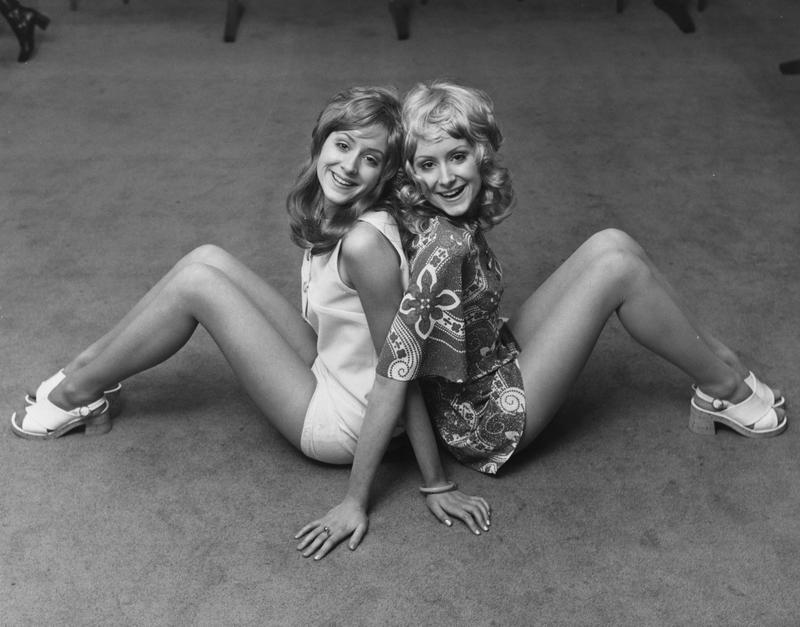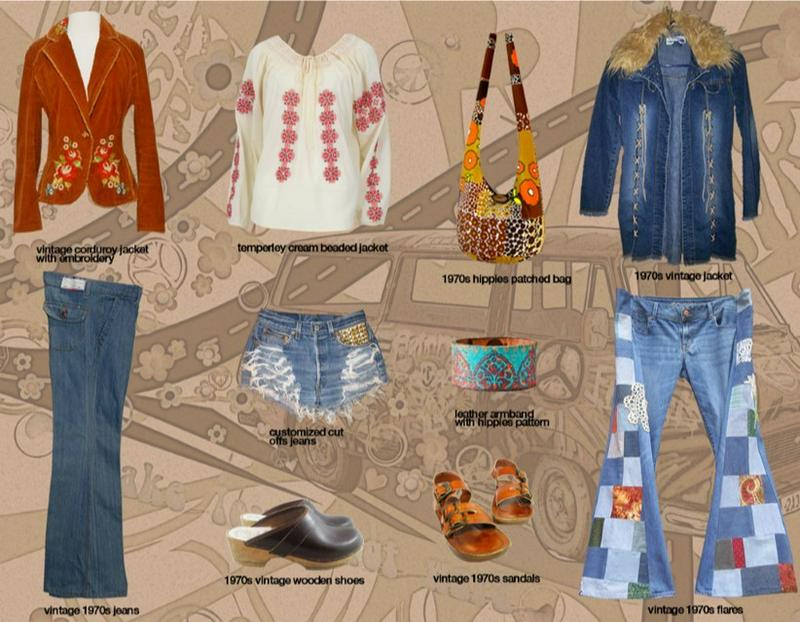The Groovy Style Of The Post-Hippie 1970's
By | March 9, 2018

Hot pants, along with mini skirts, was the greatest fashion gift to men. Launched in Britain by fashion designer Mary Quant during the “Swinging London” era, these super short shorts were fashionable until the early 1970's. At the end of the year, LIFE Magazine summed up the 1970's style this way: “Hot Pants: A short but happy career.”
Hot Pants Sell Seats
Southwest Airlines of Texas in the 1970's required that stewardesses had to be able to wear hot pants and leather boots or they weren't hired for the job. In keeping with the airline’s motto, ‘sex sells seats’, girls were selected for their looks and their pretty legs. No one was surprised about the in-flight drinks with names like ‘Passion Punch’ and ‘Love Potion’.

Fashion in the 1970's began with the persistence of mini-skirts, bell-bottoms, and the androgynous hippie look from the late 1960's. It eventually became an iconic decade for fashion.
In general, one of the most famous “looks” of the mid and late 1970’s, for both men and women, was that of wearing tight tops and loose bottoms. The 1970’s also gave birth to the indifferent, anti-conformist casual-chic approach to fashion. Included in this style was sweaters, t-shirts, jeans and sneakers.

Bell bottoms were all the rage!
Ironically, the cut that had previously been a symbol of rebellion and “anti-fashion” became a full-blown trend that would characterize the 60’s and 70’s to future generations.
Designers, no longer put off by the stigma of bell-bottoms as clothing for “dangerous radicals”, began making the pants in a wide variety of materials, denim in particular. The cut typically followed a general formula: skintight at the waist, and flaring out from the knee to the hem. Some wore flares so wide they were referred to as “elephant bells.”
Platform shoes were popular in 1970's fashion.
In the 1970's, bell-bottoms gained national attention on the Sonny and Cher show. They sold fairly well in both Europe and America and became part of the disco look in the mid ‘70s. This proved to be the downfall of bell-bottoms. Disco was a short-lived era in music and by 1979, the popular pants style, along with the polyester leisure suits and platform shoes, became a thing of the past to be bought only people looking for vintage clothing.

Flared jeans and other pants were popular with both men and women.

By the early 1970’s, mini-skirts had reached an all-time popularity.
The 1970’s began a decade with the continuation of the hippie look of the 1960s’. This decade had a distinct fashion movement going on and just about anything went. Popular fashions for women in the early 70’s included tie dyed t-shirts, peasant blouses, folk-embroidered Hungarian blouses, ponchos, capes, and military surplus clothing. Bottom attire for women during this time included bell-bottoms, gauchos, frayed jeans, midi skirts, and ankle-length maxi dresses. During this time, clothing was manufactured in extremely bright colors, as well as “loud” patterns including Native American patterns, and floral patterns. Women’s accessories of the early 1970’s included chokers, dog collars, handmade necklaces and jewelry made out of natural materials like wood, shells, stones, feathers, beads and leather. These accessories had all but replaced typical jewelry. Unisex hippie accessories included headbands, floppy hats, flowing scarves, Birkenstocks, and earth shoes. It was a very distinct look.

Mini-skirts, and other fashion trends from the groovy disco era.

In 1977, fashion changed just a little bit and became less form-fitting and baggier. This caused somewhat of a stir when women who were blessed with trim figures lamented about not being able to flaunt what they had. On the other hand, the heavier women complained that the looser clothes made them look even larger. It seems as if no one was happy! So, what the heck?

As a concession for all of this “unhappiness,” it became fashionable to show a little more skin. As a result, shirts were being worn unbuttoned, sleeves were being rolled up, and tops were being worn strapless, see-through, and lacy. Shiny satin and gold colors were also popular then and were used to make up for the lack of tighter clothing.

1978 ushered in much curvier clothing styles. Tops started coming with shoulder pads (to look like Linda Evans), tighter skirts, and narrower waistlines. The silhouette that resulted was an inverted triangle. The general fashion world went wild and it was very positively received by the general public. By this time, pants were worn flared slightly less and sometimes not flared at all.

Swedish model, Ulla Jones
Although the hippie look was widespread at the time, it was not assumed by everyone. Many women still continued to dress up with more glamorous clothes, inspired by 1940s movie star glamour. Other women just began to wear simple casual fashions or combined new garments with carefully chosen secondhand or vintage clothing from the 1930s, 1950s and 1960s.
More simple early 1970’s trends for women included fitted blazers with wide lapels, long and short dresses, mini-skirts, maxi skirts and evening gowns, hot pants (very, very tight-fitting shorts) paired with skin-tight T-shirts, his & hers outfits (matching outfits that were nearly identical to each other), and flared pants. Pastel colors were most commonly used for this style of clothing, including mauve, peach, apple green, pink, yellow, white, wheat, camel, gray, and baby blue (GAG!). Rust, tangerine, copper, forest green, and pistachio became more popular starting in 1973 and going forward.
Sweaters were a hugely popular in the early 1970s. Often, an entire outfit was seemingly judged entirely by the ever-popular sweater. This fragmented into other styles like sweater coats, sweater dresses, floor-length sweaters, and even sweater suits. Many of these popular sweater garments were trimmed with fur, especially faux. Chunky, shawl-collared, belted cardigans, often in brown and white, were also commonly seen.
Disco fashion was generally inspired by clothing from the early 1960s. Disco clothes worn by women included tube tops, sequined halter tops, blazers, spandex short-shorts, loose pants, form-fitting spandex pants, maxi skirts and dresses with long thigh slits, jersey wrap dresses, ball gowns, and evening gowns. Shoes ranged from knee-high boots to kitten heels, but the most commonly worn shoes were ones that had thick heels and were often made with see-through plastic.
The disco style of fashion allowed for a greater emphasis on being an individual. This style promoted looks that captured the wearer’s preferences and individually. Fashionistas were able to be bold and impulsive. V-necks and extremely high cut slits in dresses and skirts were very fashionable. Leather punk “looks” and other styles that were considered futuristic were being worn. Fashion had become almost aggressive.
Disco chic was how this style came to be known. Men wore cowboy boots, leisure suits, casual pants and other sportswear separates. The all in one disco jumpsuit was also popular for a time. Extra wide lapels and snugly fitting trousers were a huge hit with the ladies!
Up until then, the fashion world had been dominated by women. Fashion sense was widely considered to be feminine. Finally, men could be fashionably expressive without being criticized! It was all part of the movement. The new generation of men was becoming more liberated. They could finally be openly, fashionably expressive.

“Saturday Night Fever” was a theatrical, disco fashion time capsule.
A man could be sophisticated, macho and virile without crossing the social taboo lines! It was a win/win! After all, a man must be and feel masculine at all times. That is just the way it is!
Disco dance clubs became somewhat of a fashion show. It allowed fashion freedom, individuality and creativity, all with a captive audience. There was no limit to the possibilities and people were feeling it. It was liberating to be unapologetically expressive. It was dramatic and glamourous!
All of this being said, I’m sure we have all looked back a time or two and thought, “Oh, my God!” What was I thinking? As it turns out, however, we have nothing to worry about. We can always hide the pictures and if nothing else, we know that history has proven that fashion cycles. Everything old becomes new and fashion is no different. Don’t get rid of that questionable piece of clothing hanging in you closet. Given enough time, it will be back in style at some point!
